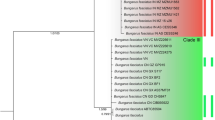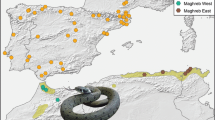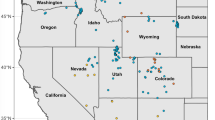Abstract
The Broad-headed snake Hoplocephalus bungaroides is one of Australia’s most endangered vertebrates. Extant populations of H. bungaroides are restricted to several geographically isolated reserves to the north, west, and south of Sydney. We analysed mitochondrial DNA from 184 specimens drawn from across the geographic range of the Broad-headed snake. Phylogenetic analysis demonstrated that H. bungaroides comprises two divergent mitochondrial lineages with a “northern” clade comprising populations west and north of Sydney and a “southern” clade comprising animals in Morton National Park. The two clades differ by an uncorrected genetic distance of 1.7%, which implies a divergence dating to approximately 755,000–850,000 years ago. We complemented our molecular data set with a detailed analysis of morphological variation both between and within the genetic clades. The two H. bungaroides genetic clades are morphologically indistinguishable and show little sexual dimorphism. Our results demonstrate that the populations north and south of this biogeographic split function as two distinct populations with no recent gene flow. There is no reason for separate taxonomic recognition of these two clades, but they do represent distinct evolutionarily significant units (ESUs) that require separate conservation management. In addition, within the northern ESU, populations from Royal National Park, Blue Mountains National Park, Wollemi National Park, and the Sydney Water Catchment supply areas should be considered as separate management units to conserve both evolutionary and ecological processes.


Similar content being viewed by others
References
Arévalo E, Davis SK, Sites J (1994) Mitochondrial DNA sequence divergence and phylogenetic relationships among eight chromosome races of the Sceloporus grammicus complex (Phrynosomatidae) in Central Mexico. Syst Biol 43:387–418. doi:10.2307/2413675
Avise JC (2004) Molecular markers, natural history and evolution, 2nd edn. Sinauer Associates Inc., Sunderland
Branagan DF, Packham GH (2000) Field geology of New South Wales, 3rd edn. Department of Mineral Resources, Sydney
Brown M, Cooksley H, Carthew SM, Cooper SJB (2006) Conservation units and phylogeographic structure of an arboreal marsupial, the yellow-bellied glider (Petaurus australis). Aust J Zool 54:305–317. doi:10.1071/ZO06034
Burns EL, Eldridge MDB, Crayn DM, Houlden BA (2007) Low phylogeographic structure in a wide spread endangered Australian frog Litoria aurea (Anura: Hylidae). Conserv Genet 8:17–32. doi:10.1007/s10592-006-9143-8
Byrne M (2008) Evidence for multiple refugia at different time scales during Pleistocene climatic oscillations in southern Australia inferred from phylogeography. Quat Sci Rev 27:2576–2585. doi:10.1016/j.quascirev.2008.08.032
Caughley G, Gunn A (1996) Conservation biology in theory and practise. Blackwell Science, Cambridge
Cogger HG (2000) Reptiles and amphibians of Australia, 6th edn. Reed New Holland, Sydney
Croak BM, Pike DA, Webb JK, Shine R (2009) Using artificial rocks to restore non-renewable shelter sites in human-degraded systems: colonization by fauna. Restor Ecol. doi:10.1111/j.1526-100X.2008.00476.x
Dodson JR (1994) Quaternary vegetation history. In: Groves RH (ed) Australian vegetation. Cambridge University Press, Cambridge, pp 37–56
Fischer J, Lindenmayer DB (2000) An assessment of the published results of animal relocations. Biol Conserv 96:1–11. doi:10.1016/S0006-3207(00)00048-3
Foreman RTT, Alexander LE (1998) Roads and their major ecological effects. Annu Rev Ecol Syst 29:207–231. doi:10.1146/annurev.ecolsys.29.1.207
Frankel OH (1974) Genetic conservation: our evolutionary responsibility. Genetics 78:53–65
Goldingay R (1998) Between a rock and a hard place: conserving the Broad-headed snake in Australia’s oldest National Park. Proc Linn Soc N S W 120:1–10
Goldingay RL, Newell DA (2000) Experimental rock outcrops reveal continuing habitat disturbance for an endangered Australian snake. Conserv Biol 14:1908–1912. doi:10.1046/j.1523-1739.2000.99458.x
Goodman D (1987) The demography of chance extinction. In: Soule ME (ed) Viable populations for conservation. Cambridge University Press, Cambridge, pp 11–34
Hersey F (1980) Broad-headed snake, Hoplocephalus bungaroides. In: Haegl C (ed) Endangered animals of New South Wales. National Parks and Wildlife Service, Sydney, pp 38–40
Hobbs RJ, Yates CJ (2003) Turner review no. 7. Impacts of ecosystem fragmentation on plant populations: generalising the idiosyncratic. Aust J Bot 51:471–488. doi:10.1071/BT03037
Huelsenbeck JP, Ronquist F (2001) MRBAYES: Bayesian inference of phylogenetic trees. Bioinformatics 17:754–755. doi:10.1093/bioinformatics/17.8.754
James CH, Moritz C (2000) Intraspecific phylogeography in the sedge frog Litoria fallax (Hylidae) indicates pre-Pleistocene vicariance of an open forest species from eastern Australia. Mol Ecol 9:349–358. doi:10.1046/j.1365-294x.2000.00885.x
Jones ME, Shepherd M, Henry RJ, Delves A (2006) Chloroplast DNA variation and population structure in the widespread forest tree, Eucalyptus grandis. Conserv Genet 7:691–703. doi:10.1007/s10592-005-9104-7
Keogh JS, Shine R, Donnellan S (1998) Phylogenetic relationships of terrestrial Australo-Papuan elapid snakes based on cytochrome b and 16S rRNA sequences. Mol Phylo Evol 10:67–81. doi:10.1006/mpev.1997.0471
Keogh JS, Scott IAW, Scanlon JD (2000) Molecular phylogeny of viviparous Australian elapid snakes: affinities of ‘Echiopsis’ atriceps (Storr, 1980) and ‘Drysdalia’ coronata (Schlegel, 1837), with description of a new genus. J Zool 252:317–326. doi:10.1111/j.1469-7998.2000.tb00626 (Lond)
Keogh JS, Scott IAW, Fitzgerald M, Shine R (2003) Molecular phylogeny of the Australian venomous snake genus Hoplocephalus and conservation genetics of the threatened H. stephensii. Conserv Genet 4:57–65. doi:10.1023/A:1021823423944
Krefft G (1869) The snakes of Australia; an illustrated and descriptive catalogue of all the known species. T Richards, Govt. Printer, Sydney
Mader HJ (1984) Animal habitat isolation by roads and agricultural fields. Biol Conserv 29:81–96. doi:10.1016/0006-3207(84)90015-6
McKinney ML (1997) Extinction vulnerability and selectivity: combining ecological and paleontological views. Annu Rev Ecol Syst 28:495–516. doi:10.1146/annurev.ecolsys.28.1.495
Moritz C (1994a) Defining evolutionarily significant units for conservation. Trends Ecol Evol 9:373–375. doi:10.1016/0169-5347(94)90057-4
Moritz C (1994b) Applications of mitochondrial DNA analysis in conservation: critical review. Mol Ecol 3:401–411. doi:10.1111/j.1365-294X.1994.tb00080.x
Moritz C (2002) Strategies to protect biological diversity and the evolutionary processes that sustain it. Syst Biol 51:238–254. doi:10.1080/10635150252899752
Newell DA, Goldingay RL (2005) Distribution and habitat assessment of the Broad-headed snake Hoplocephalus bungaroides. Aust Zool 33:168–179
Pringle RM, Webb JK, Shine R (2003) Canopy structure, microclimate, and habitat selection by a nocturnal snake, Hoplocephalus bungaroides. Ecology 84:2668–2679. doi:10.1890/02-0482
Roe JH, Gibson J, Kingsbury BA (2006) Beyond the wetland border: estimating the impact of roads for two species of water snakes. Biol Conserv 130:161–168. doi:10.1016/j.biocon.2005.12.010
Sanders KL, Lee MSY, Leijs R, Foster R, Keogh JS (2008) Molecular phylogeny and divergence dates for Australasian elapids and sea snakes (Hydrophiinae): evidence from seven genes for rapid evolutionary radiations. J Evol Biol 21:882–895. doi:10.1111/j.1420-9101.2008.01525.x
Saunders DA, Hobbs RJ, Margules CR (1991) Biological consequences of ecosystem fragmentation: a review. Conserv Biol 5:18–32. doi:10.1111/j.1523-1739.1991.tb00384.x
Scott IAW, Keogh JS (2000) Conservation genetics of the endangered grassland earless dragon Tympanocryptis pinguicolla (Reptilia: Agamidae) in Southeastern Australia. Conserv Genet 1:357–363. doi:10.1023/A:1011542717349
Shine R, Fitzgerald M (1989) Conservation and reproduction of an endangered species: the Broad-headed snake, Hoplocephalus bungaroides (Elapidae). Aust Zool 25:65–67
Shine R, Webb JK, Fitzgerald M, Sumner J (1998) The impact of bush-rock removal on an endangered snake species, Hoplocephalus bungaroides (Serpentes, Elapidae). Wildl Res 25:285–295. doi:10.1071/WR97022
Smith SA, Sadlier RA, Bauer AM, Austin CC, Jackman T (2007) Molecular phylogeny of the scincid lizards of New Caledonia and adjacent areas: evidence for a single origin of the endemic skinks of Tasmantis. Mol Phylo Evol 43:1151–1166. doi:10.1016/j.ympev.2007.02.007
Swofford DL (2002) PAUP*. Phylogenetic analysis using parsimony (*and other methods), version 4. Sinauer Associates, Sunderland
Wagstaff BE, Kershaw AP, O’Sullivan PB, Harle KJ, Edwards J (2001) An Early to Middle Pleistocene palynological record from the volcanic crater of Pejark Marsh, Western Plains of Victoria, southeastern Australia. Quat Int 83–85:211–232. doi:10.1016/S1040-6182(01)00041-6
Webb JK, Shine R (1997a) Out on a limb: conservation implications of tree-hollow use by a threatened snake species (Hoplocephalus bungaroides: Serpentes, Elapidae). Biol Conserv 81:21–33. doi:10.1016/S0006-3207(96)00160-7
Webb JK, Shine R (1997b) A field study of spatial ecology and movements of a threatened snake species, Hoplocephalus bungaroides. Biol Conserv 82:203–217. doi:10.1016/S0006-3207(97)00032-3
Webb JK, Shine R (1998) Using thermal ecology to predict retreat-site selection by an endangered snake species. Biol Conserv 86:233–242. doi:10.1016/S0006-3207(97)00180-8
Webb JK, Brook BW, Shine R (2002a) Reptile collectors threaten Australia’s most endangered snake, the Broad-headed snake Hoplocephalus bungaroides. Oryx 36:170–181. doi:10.1017/S0030605302000248
Webb JK, Brook BW, Shine R (2002b) What makes a species’ vulnerable to extinction? Comparative life history traits of two sympatric snakes. Ecol Res 17:59–67. doi:10.1046/j.1440-1703.2002.00463.x
Webb JK, Pringle RM, Shine R (2005) Canopy removal restores habitat quality for an endangered snake in a fire suppressed landscape. Copeia 2005:893–899. doi:10.1643/0045-8511(2005)005[0894:CRRHQF]2.0.CO;2
Acknowledgments
We thank Mark Fitzgerald and Jai Thomas for carrying out surveys for H. bungaroides, and Peter Harlow, David Pike and Simon Clulow for kindly providing tissue samples and locality data. Gary Daly and Ross Wellington provided expert advice on the distribution of Broad-headed snakes. We thank Les Mitchell, Phil Craven and Bruce Grey from the Department of Environment and Conservation (Nowra NPWS) for organising helicopter surveys and for their assistance in the field. Meagan Ewings (DEC Hurstville) helped organise surveys and assisted us during field work. We thank the curators and collection managers of all the Australian natural history museums who lent us the specimens in their care: Allen Greer and Ross Sadlier (Australian Museum), Jeanette Covacevich and Patrick Couper (Queensland Museum), John Coventry (National Museum of Victoria), Mark Hutchinson and Adrienne Edwards (South Australian Museum), and John Wombey (CSIRO Australian National Wildlife Collection). All research was carried out according to the University of Sydney Animal Care and Ethics Committee guidelines under a scientific licence from the New South Wales National Parks and Wildlife Service (Licence S10029). The research was supported financially by the Australian Research Council (grants to S. Keogh and R. Shine and a fellowship to J. Sumner), the University of Sydney (Sesqui Fellowship to J. Webb), the Australian Academy of Science (Margaret Middleton Award to J. Webb), and the Department of Environment and Climate Change NSW (grant to R. Shine).
Author information
Authors and Affiliations
Corresponding author
Rights and permissions
About this article
Cite this article
Sumner, J., Webb, J.K., Shine, R. et al. Molecular and morphological assessment of Australia’s most endangered snake, Hoplocephalus bungaroides, reveals two evolutionarily significant units for conservation. Conserv Genet 11, 747–758 (2010). https://doi.org/10.1007/s10592-009-9863-7
Received:
Accepted:
Published:
Issue Date:
DOI: https://doi.org/10.1007/s10592-009-9863-7




